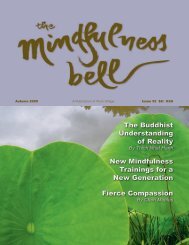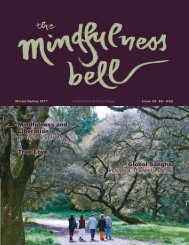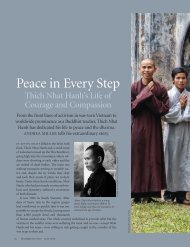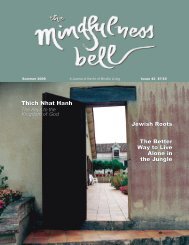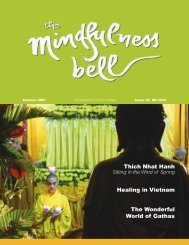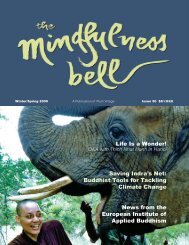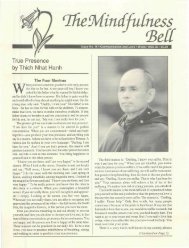View full issue in PDF - The Mindfulness Bell
View full issue in PDF - The Mindfulness Bell
View full issue in PDF - The Mindfulness Bell
- No tags were found...
Create successful ePaper yourself
Turn your PDF publications into a flip-book with our unique Google optimized e-Paper software.
lue SKY<br />
the moment. For some, tears flowed surpris<strong>in</strong>gly quickly when they<br />
turned their attention toward the ultimate reality. Bask<strong>in</strong>g <strong>in</strong> the warm<br />
attention of the listener seemed to help the process. This practice has<br />
elicited similar responses each time I have <strong>in</strong>troduced it over the past<br />
several years.<br />
Practice of Look<strong>in</strong>g Deeply at Suffer<strong>in</strong>g<br />
Ground<strong>in</strong>g oneself <strong>in</strong> the ultimate dimension can form a solid<br />
base for explor<strong>in</strong>g our pa<strong>in</strong> <strong>in</strong> the relative dimension. <strong>The</strong> Blue Sky<br />
practice can form an anchor. Repeatedly, my experience has been that<br />
when I can listen deeply to another person for a long enough time, the<br />
person often spontaneously moves toward look<strong>in</strong>g deeply at the roots<br />
of their pa<strong>in</strong>. Why do we do this so reliably My own practice over<br />
the years conv<strong>in</strong>ces me that it is a natural process.<br />
Our <strong>in</strong>herent Buddha nature gets<br />
obscured by hurt, oppression, mis<strong>in</strong>formation,<br />
lack of <strong>in</strong>formation, family<br />
condition<strong>in</strong>g, <strong>in</strong>herited cultural beliefs,<br />
and a million other forms of harm.<br />
Such accumulated hurts shape our patterns<br />
of perception, ideas of self, and<br />
other mental formations. M<strong>in</strong>dfulness<br />
meditation, practiced with diligence<br />
and persistence, can eventually penetrate<br />
these veils and once aga<strong>in</strong> put a<br />
person <strong>in</strong> touch with the freedom and<br />
equanimity of the blue sky. Pay<strong>in</strong>g<br />
attention to feel<strong>in</strong>gs, look<strong>in</strong>g at suffer<strong>in</strong>g,<br />
is not hard to do <strong>in</strong> a m<strong>in</strong>dfulness<br />
context. It is a necessary and <strong>in</strong>evitable<br />
process along the path of liberation.<br />
Recast<strong>in</strong>g the Four Noble Truths to<br />
focus on emotional h<strong>in</strong>drances might<br />
sound someth<strong>in</strong>g like this:<br />
<strong>The</strong>re is suffer<strong>in</strong>g. Here we are<br />
speak<strong>in</strong>g of emotional distress and<br />
physical hurt. Buddha named suffer<strong>in</strong>g<br />
as the first truth to help us acknowledge<br />
and accept suffer<strong>in</strong>g rather than deny<br />
or avoid it. All Western therapeutic<br />
schools likewise state that heal<strong>in</strong>g<br />
beg<strong>in</strong>s when a person faces the pa<strong>in</strong>.<br />
“It hurts.”<br />
<strong>The</strong>re is a cause of suffer<strong>in</strong>g. Buddha taught that the cause is<br />
ignorance of reality, is th<strong>in</strong>k<strong>in</strong>g there is <strong>in</strong>dependent existence, is not<br />
understand<strong>in</strong>g the impermanent nature of th<strong>in</strong>gs and try<strong>in</strong>g to hold on<br />
to what must change. Wrapped around these big <strong>issue</strong>s for any <strong>in</strong>dividual<br />
are the scars of untold layers of hurtful experiences—th<strong>in</strong>gs that<br />
happened to the person because he or she is born <strong>in</strong>to a whole world<br />
<strong>full</strong> of suffer<strong>in</strong>g and falseness. Th<strong>in</strong>gs like be<strong>in</strong>g unloved, scorned,<br />
rejected, not valued, humiliated, abused, disrespected, mis-educated,<br />
oppressed, ignored, not welcomed, lied to, mistreated, made to feel<br />
powerless, misled, physically hurt, pampered <strong>in</strong>to numbness, not accepted,<br />
<strong>in</strong>sulted, demeaned, or made to be afraid.<br />
<strong>The</strong>re is a way out of suffer<strong>in</strong>g. For Buddha, understand<strong>in</strong>g the<br />
nature of reality meant liberation from suffer<strong>in</strong>g. Along the emotional<br />
heal<strong>in</strong>g path, <strong>in</strong>creased freedom from suffer<strong>in</strong>g comes as a person<br />
heals past trauma, reevaluates the past, sheds old patterns of thought<br />
and behavior, and gradually identifies with a healthier sense of self.<br />
As many people have noted, one has to have a strong, <strong>in</strong>tegrated ego<br />
<strong>in</strong> order to transcend the ego and move to the deeper <strong>in</strong>sights that<br />
Buddha taught. Buddhist psychology speaks of purification as a step<br />
towards liberation.<br />
<strong>The</strong> practice of the path is the means for end<strong>in</strong>g suffer<strong>in</strong>g. Buddha<br />
put forth a comprehensive Eightfold Path—a set of moral guidel<strong>in</strong>es,<br />
concentration practices, conceptual directions, and practices for daily<br />
liv<strong>in</strong>g that, if followed diligently, can lead to <strong>in</strong>sight and the transformation<br />
of suffer<strong>in</strong>g. What might be some elements of the path to<br />
end emotional suffer<strong>in</strong>g Here are ones that I have found useful and<br />
consistent with Buddhist teach<strong>in</strong>gs.<br />
• Cultivate a noble view of<br />
human be<strong>in</strong>gs. Know that every<br />
human be<strong>in</strong>g, by nature, is Buddhalike.<br />
I use this description:<br />
By nature, human be<strong>in</strong>gs are<br />
- <strong>in</strong>herently valuable<br />
- deeply car<strong>in</strong>g<br />
- enormously <strong>in</strong>telligent<br />
- immensely powerful<br />
- <strong>in</strong>f<strong>in</strong>itely creative<br />
- naturally cooperative<br />
- <strong>in</strong>nately joyful<br />
Whenever I’ve asked a group of<br />
people to repeat these words out loud,<br />
the tone rises immediately. Why Because<br />
the words reach for the noblest<br />
of human characteristics, and most of<br />
us <strong>in</strong>tuitively know that we are these<br />
th<strong>in</strong>gs, if we could only be free of<br />
what holds us back. I could say that<br />
by nature, human be<strong>in</strong>gs are impermanent,<br />
aimless, and empty, but these<br />
words don’t <strong>in</strong>stantly resonate with<br />
most people <strong>in</strong> the West like the first<br />
set of words!<br />
photo by Suzanne Anderson • Listen deeply. What are the<br />
elements of deep listen<strong>in</strong>g We<br />
practice these <strong>in</strong> our Sanghas.<br />
- Hold the person <strong>in</strong> high regard; visualize their Buddha nature.<br />
- Treat the person with complete respect.<br />
- Be present and available.<br />
- Assume the person knows best how to lead his or her life.<br />
- Communicate acceptance and lack of judgment.<br />
- Give your undivided attention, focused concentration, and m<strong>in</strong>dful<br />
awareness.<br />
- Encourage awareness and recognition of feel<strong>in</strong>gs; recognize that<br />
release is a key component of heal<strong>in</strong>g.<br />
Deep listen<strong>in</strong>g is a powerful tool for heal<strong>in</strong>g. Our listen<strong>in</strong>g can<br />
improve with practice. Invok<strong>in</strong>g Avalokiteshvara’s name states: “We<br />
aspire to learn your way of listen<strong>in</strong>g <strong>in</strong> order to help relieve suffer<strong>in</strong>g <strong>in</strong><br />
38 Summer 2004



